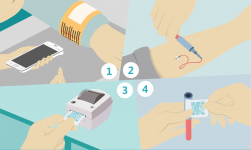
RFID solution for sample collection in smart medical care
[ad_1]
Fully closed-loop label printing management, intelligent control of sample collection and pairing
Whether the sample can be accurately mapped to the patient is directly related to whether the examination result can truly and objectively reflect the patient’s current condition. When handling biological samples, even if the relevant staff have been extra careful, the hospital still needs to collect smarter and more scientific methods to ensure the correct correspondence between the patient and the sample, and to achieve real-time information such as sample source, collection time, processing status, and use history Record and view.
Industry Status
In sample collection, nursing staff usually print out all patient labels in advance and stick them on each empty test tube; verbally confirm the identity before collection, it may happen that the collected sample does not correspond to the patient on the label;
Once the corresponding error, it is very likely to lead to wrong test results, or even improper governance, which will cause immeasurable losses to the hospital.
Application Introduction
Bedside collection
When collecting the patient’s physical signs, find the corresponding physical signs collection doctor’s order through the PDA, enter the execution interface, scan the patient’s wristband to confirm the patient’s identity information, and perform sample collection when it is confirmed.
Connect the patient bedside printer through the PDA, print the sample label containing the patient’s information, and paste the label outside the sample container after the collection is completed, and the sample label is automatically paired with the patient.
Even if the nurse collects samples of multiple patients at the same time, there is no need to worry about the samples being confused, and the work efficiency is higher.

Generate electronic reports
The laboratory staff can use the PDA to scan the label outside the sample to quickly obtain the corresponding or information, and after the inspection is completed, the corresponding test results or data analysis and other information can be input into the system through the PDA;
The system automatically counts, analyzes and generates reports, and then shares them to the management system by connecting to the wireless network;
Through the Internet, doctors can combine patient information to view sample test results and make reasonable diagnosis and treatment plans in a timely manner.
 ?
?
Application advantage
Print sample test tube labels at the bedside immediately within the line of sight, with a fully closed loop process to avoid mislabeling;
Once the correct patient-sample correspondence is determined, mistakes in diagnosis and improper treatment can be avoided, and the most effective and accurate treatment plan can be provided for patients.
Many intermediate links such as printing reports and fetching paper reports are reduced, which helps to improve the work efficiency of doctors. At the same time, it can reduce the use of paper.
[ad_2]



